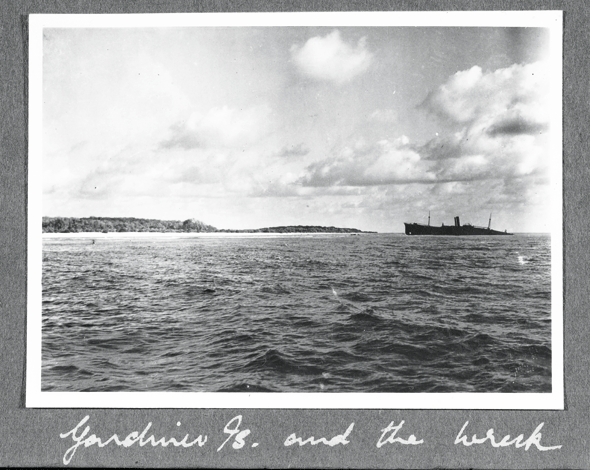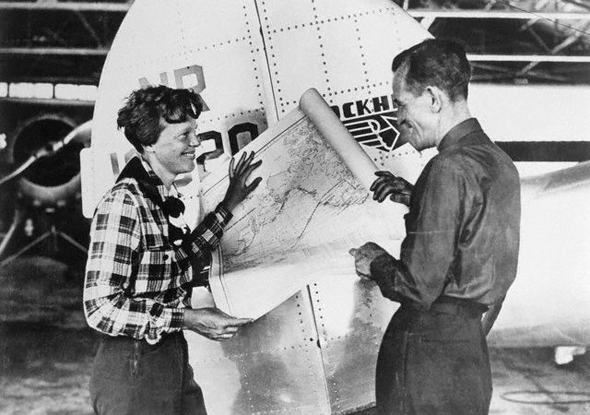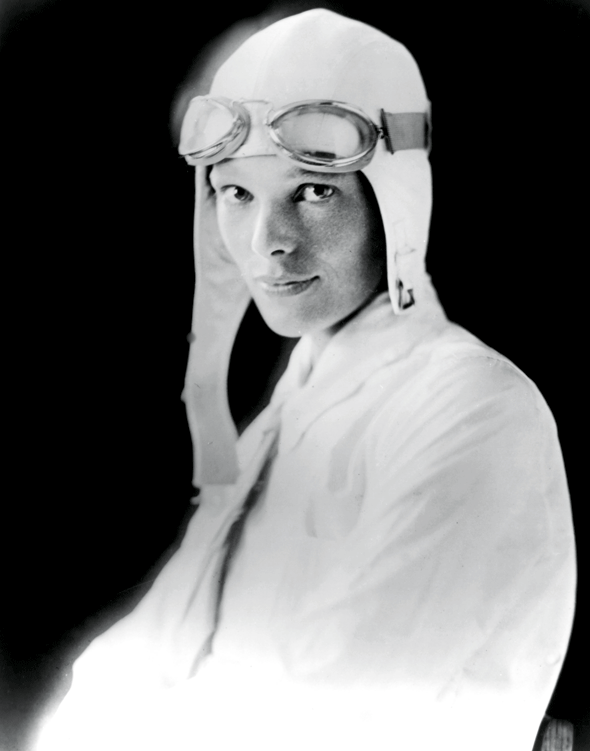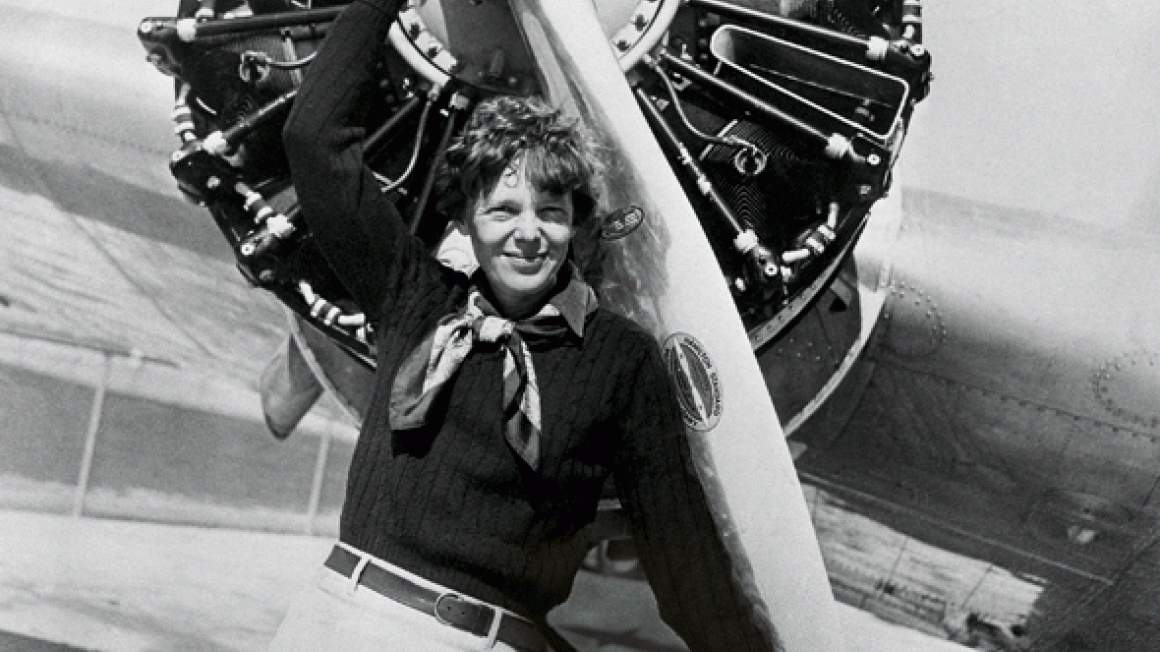Is this the answer to the Amelia Earhart riddle?
She died at sea in 1937. She died on Saipan in 1944. She died in New Jersey in 1983. She's on a Pacific island, the oldest living being, but alive and well today... The disappearance of Amelia Earhart is one of the great mysteries of the 20th century. Seventy-five years ago, in July 1937, she attempted to become the first woman to fly around the world. She was less than a month away from her 40th birthday when her plane went missing over the Pacific Ocean. In American folklore, only the assassination of John F Kennedy compares with the disappearance of Amelia Earhart.
Inextricably connected with the Earhart legend is the United States Navy and the greatest organised effort ever undertaken on behalf of a lost flier. The US Government spent $4m looking for her. The massive search for the pilot and her navigator Fred Noonan continued for more than two weeks. It became the most extensive air and sea search in naval history, scouring 250,000 miles of ocean, involving 3,000 men, 10 ships, and 102 American planes. But neither the plane nor anything else identifying Earhart or Noonan was ever discovered. She was a truly inspiring woman, but why was such a huge effort mounted? And why did it fail? What was really going on? Was there a secret agenda? Was there a cover-up? Was she a spy? Seven-and-a-half decades after her disappearance, it still remains the subject of investigation.

Her audacious journey is etched in history books across the globe, and her unexplained disappearance still boggles the mind of researchers worldwide. Many believe the plane ran out of fuel and Earhart and Noonan ditched at sea. Others suggest they may have own to Gardner Island (now Nikumaroro) in the Pacific, landed there, and ultimately perished.
But her fate isn't just the stuff of conspiracy theory. Finding her, and solving the riddle of her disappearance, remains a very real enterprise – even nearly eight decades on.
Indeed, a new search may finally solve the mystery of what really happened to Amelia Earhart. Last month, US Government officials and a private historical group announced a new $500,000 effort to locate Earhart's Lockheed Electra plane.
Triggering the decision is the recent discovery of a photo taken in October 1937 by a British soldier off the coast of the remote island of Nikumaroro. Experts now believe it shows a portion of the landing gear of the same plane that Amelia was piloting sticking out of the water. Searchers are hoping to locate the wreckage of the plane and possibly even the remains of Earhart and Noonan. They believe the fliers may have managed to land on a reef abutting Gardner Island and survived for a short time – and that the plane was washed off the reef by high tides shortly after the landing.
Previous visits to the island recovered artefacts that could have belonged to Earhart and Noonan, suggesting they might have lived there for days or even weeks. This time, the search will last for 10 days in July and will use state-of-the-art underwater robotic submarines and mapping equipment.
Secretary of State Hillary Clinton, an admirer of Amelia, welcomed plans for the expedition. And she hailed Earhart as an inspiration, both past and present.
'Amelia Earhart may have been an unlikely heroine for a nation down on its luck,' she said, 'but she embodies the spirit of an America coming of age and increasingly confident, ready to lead in a quite uncertain and dangerous world. She gave people hope and she inspired them to dream bigger and bolder.
'Today,' said Mrs Clinton, 'we meet at a time when the challenges are not so dire, despite what you might hear on television or radio. But these are still difficult days for many Americans. After a long decade of war, terrorism and recession, there are some who are asking whether we still have what it takes to lead, and like that earlier generation we too could use some of Amelia's spirit.
'We can be as optimistic and even audacious as Amelia Earhart. We can be defined not by the limits that hold us down but by the opportunities that are ahead.'
Certainly Amelia grabbed with both hands the opportunities that lay before her. She was a true icon of her age.
She was 23 when she took her first ride in an aeroplane. Instantly smitten, she began flying lessons the next week. Within a year she had bought her first plane – within two, she had set her first aviation record with an unofficial women's altitude record of 14,000 feet.
The records flew by after that: first woman to fly solo nonstop across both the Atlantic and Pacific Oceans; she broke the women's flying speed record; and logged the first and fastest nonstop transcontinental flight.
Amelia lectured around the country, often speaking in two different cities in the same day. Her 'little red bus', a bright red Lockheed Vega, could transport her faster than any limousine. The public nicknamed her 'Lady Lindy' because of her resemblance to Charles Lindbergh (who was known as 'Lucky Lindy').

She was an accomplished writer and was Cosmopolitan magazine's Aviation Editor for a couple of years in the late 1920s. While writing numerous magazine articles and essays, she also published two books based upon her experiences as a flyer. And she married publisher George Putnam in what she dubbed an open marriage.
In a letter written to Putnam shortly before their wedding, she said, 'I want you to understand I shall not hold you to any midaevil [sic] code of faithfulness to me nor shall I consider myself bound to you similarly.'
In 1937, Amelia's first attempt to fly around the globe failed when her plane aborted its takeoff and was damaged. Three months later she tried again. Her flight seemed headed for success by the time she reached the Pacific. But soon after refuelling in New Guinea and taking off on the last, most hazardous leg of her journey, the US Coast Guard cutter who was tracking her movements lost radio contact with her during a storm. Her final, frantic scrambled radio transmissions to the crew of the cutter, possibly indicating that she was lost, added to the mystery.
Despite a massive search by the US Government, no trace of Earhart, Noonan, or their plane was ever found. George Putnam continued to finance his own search for another three months until sadly giving up in October 1937.
During the decades since her disappearance, many rumours have circulated about what might have happened to Earhart and Noonan. One of the theories was that they were captured and executed when their plane crashed in the Saipan archipelago while it was under Japanese occupation.
It was also suggested that Earhart was spying for the US and was captured when her plane went down under fire. Some believed Amelia was forced to make propaganda radio broadcasts as one of the many women known as Tokyo Rose. However, George Putnam personally investigated this rumour, but after listening to recordings of numerous Tokyo Roses, he was unable to recognise her voice among them.
Others have suggested Earhart later managed to return to America where she changed her name and lived out her life quietly, a theory endorsed by evidence unearthed several years ago by British film director Ken Annakin. He claimed to have spoken to her relatives in New Zealand and told me he had evidence that Amelia had survived and returned to the United States to live in anonymity. He died before he could reveal that evidence.
Three months after the Navy concluded that Amelia Earhart must have died in a crash, a small British expedition on Gardner Island found unexplained signs of previous habitation on the atoll.
The following year, they came upon the skeleton of a woman with 'shoes of the American kind, size nine narrow'.
Subsequent expeditions to Gardner Island in 1989 and 1991 recovered aircraft wreckage consistent with Earhart's Lockheed, as well as personal effects that included the remains of an American shoe identical in style and size to that worn by Earhart on her last flight.
In a letter to her husband, written in case a dangerous flight proved to be her last, her spirit was evident. 'Please know I am quite aware of the hazards,' she wrote. 'I want to do it because I want to do it. Women must try to do things as men have tried. When they fail, their failure must be but a challenge to others.'
Amelia's life was a spellbinding journey from unknown individual to unforgettable legend. A legend that survives with its endless myths and its reality preserved by Putnam in Amelia's own scrapbooks and writings. Along with thousands of files from the FBI, the US State Department and the US Navy, including documents covering an investigation by the Japanese government into allegations that Earhart was imprisoned on Saipan in 1937.
Today, though many theories exist, there is still no concrete proof of Amelia's fate. But as the 75th anniversary of her disappearance looms and a new search gets underway, the world continues to remember Amelia Earhart for her courage, vision, and ground-breaking achievements, both as an aviator and a feminist. Amelia Earhart was an icon who blazed a trail of achievement for generations of women who came after her.
As her friend Gore Vidal once famously declared: 'Forget Garbo, forget Jackie. Amelia was in a realm beyond stardom.'

MAKING OF A LADY AVIATOR
Amelia Mary Earhart was born 24 July 1897, in Atchison, Kansas and was named after her two grandmothers. From an early age, she loved 'rough and tumble' play.
She saw her first aircraft, aged 10, at the Iowa State Fair in Des Moines. But she wasn't thrilled, calling it 'a thing of rusty wire and wood and not at all interesting'.
During the 1918 Spanish flu epidemic, she was a nurse in Toronto and caught pneumonia herself. It took nearly a year for her to fully recover.
Around this time, a rather macho First World War ace flew his plane at her during an air show. She bravely stood still, and said later, 'I did not understand it at the time, but I believe that little red airplane said something to me as it swished by'.
In 1920, her father paid $10 for her to take a short flight with Frank Hawks. 'By the time I had got two or three hundred feet off the ground, I knew I had to fly,' she said.



